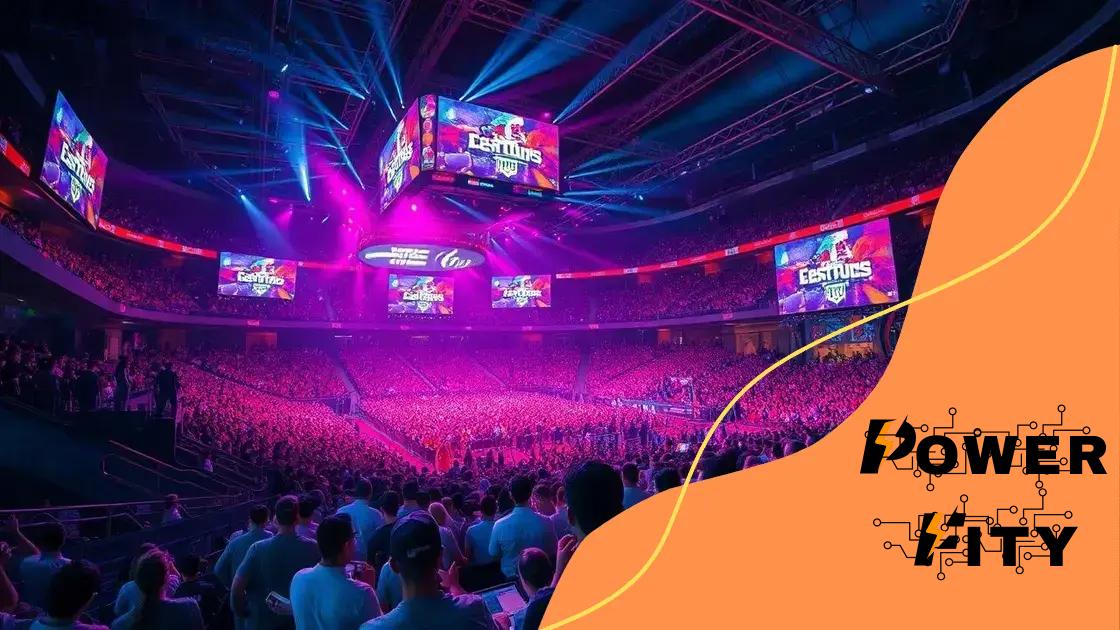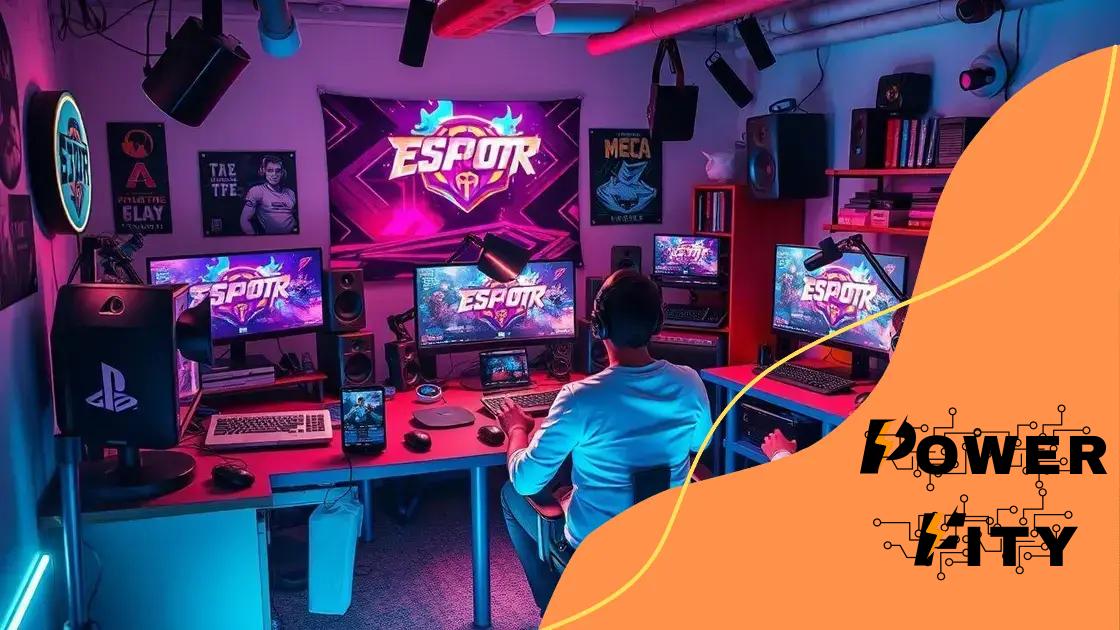How e-sports are influencing mainstream media content

How e-sports are influencing mainstream media content includes changing viewer habits, integrating interactive experiences, and fostering collaborations that enhance engagement and audience reach.
How e-sports are influencing mainstream media content is more than just a trend; it’s a significant shift in how we consume entertainment. Have you noticed how gaming has slowly integrated into our favorite shows and events? Let’s dive into this phenomenon.
The rise of e-sports and its audience
The rise of e-sports has transformed the way we view competitive gaming and its audience. This vibrant community is not just about gaming; it’s a cultural movement that extends into mainstream entertainment.
In recent years, e-sports have garnered massive popularity, appealing to millions of viewers around the globe. The audience for e-sports is diverse, ranging from casual gamers to hardcore fans who follow their favorite teams and players religiously. This shift in engagement is crucial for understanding why e-sports have captured the attention of media outlets.
Understanding the Demographics
The e-sports audience is unique, consisting of various age groups, interests, and backgrounds. Here are some notable demographics:
- Age: A large percentage of viewers are aged between 18 and 34.
- Gender: While traditionally male-dominated, the number of female viewers is steadily increasing.
- Engagement: Fans often participate via social media and live chats during streams.
This widespread appeal can be attributed to the interactive nature of e-sports, which allows fans to engage in ways traditional sports have not. For instance, platforms like Twitch enable real-time communication between players and viewers, making the experience far more immersive. This interaction creates a strong sense of community among fans.
What Draws Audiences to E-sports?
The excitement of competitive gaming attracts viewers for several reasons. Here are some key factors:
- High-energy competitions: The intensity of matches keeps viewers on the edge of their seats.
- Diverse gameplay: Different genres offer something for everyone, from strategy games to first-person shooters.
- Star players: Many fans follow their favorite players, much like in traditional sports.
Moreover, major events like the League of Legends World Championship and The International have seen viewership numbers rivaling those of traditional sporting events. For instance, in 2021, the League of Legends finals pulled in over 4 million concurrent viewers. Such numbers reflect the significant impact e-sports have on entertainment trends.
In essence, the rise of e-sports has reshaped not just the gaming industry but also the way we consume media. As this phenomenon continues to grow, it remains clear that e-sports will influence various aspects of mainstream media, from content creation to sponsorship opportunities.
Impact of e-sports on traditional media
The impact of e-sports on traditional media is profound and far-reaching. Recently, we’ve witnessed a significant shift in how media outlets are adapting to this growing phenomenon. This transition integrates gaming culture into television, streaming services, and social media platforms, changing the landscape of entertainment.
Television networks have started broadcasting e-sports tournaments, recognizing the vast audience it attracts. Major events like the Overwatch League and Dota 2’s The International have gained prime time slots, appealing to younger viewers who might otherwise not tune into traditional sports. The excitement of live gaming creates thrilling content that keeps audiences engaged.
Changing Viewership Trends
As e-sports rise in popularity, traditional media is noticing shifts in viewing habits:
- Audience demographics: Many e-sports fans are under 35, a key age group that traditional media finds challenging to engage.
- Multiplatform consumption: Viewers are often consuming e-sports content on various platforms like Twitch, YouTube, and social media, not just TV.
- Interactive content: Fans engage with e-sports through live chats, polls, and community discussions.
This engagement shows a deeper connection to players and teams, akin to traditional sports fandom. By featuring gamers and hosting live events, traditional media can draw in a vibrant, interactive audience.
Sponsorship and Advertising Opportunities
The growing popularity of e-sports also creates new sponsorship opportunities for brands. Companies are eager to target the young, tech-savvy audience that e-sports attract. Notable brands like Coca-Cola and Intel have partnered with e-sports leagues, integrating their products into tournaments and events. This approach not only promotes brand visibility but also enhances the overall experience for fans.
Moreover, traditional media companies are recognizing the value of these partnerships. Investing in e-sports content can provide a fresh avenue for revenue. By collaborating with e-sports influencers, they can create engaging promotional campaigns that resonate with the target audience.
In summary, the impact of e-sports on traditional media is undeniable. As media platforms continue to evolve, embracing e-sports will be essential to stay relevant and capture the interest of modern audiences.
How e-sports are shaping content creation

How e-sports are shaping content creation is a key topic in today’s ever-evolving media landscape. The fusion of competitive gaming with creative content has opened new opportunities for producers, artists, and gamers alike.
As e-sports continue to grow, they influence not only the way content is consumed but also how it is created. Content creators are harnessing the excitement of e-sports to craft videos, streams, and even narratives that captivate audiences. This new wave of content goes beyond mere gameplay, embedding stories, personalities, and community engagement.
Innovative Formats and Engagement
One significant aspect of this transformation is the development of innovative formats that resonate with fans:
- Live Streaming: Platforms like Twitch and YouTube Gaming allow fans to engage with their favorite players in real time.
- Vlogs and Behind-the-Scenes: Community members enjoy seeing personal stories, practices, and the daily lives of gamers.
- Collaborative Content: Teams and players work together to create unique videos that highlight their skills and personalities.
This variety in formats not only keeps the content fresh but also helps form a stronger connection between creators and their audience. Fans become more than just viewers; they become active participants in the gaming culture.
The Role of Influencers
Influencers play a crucial role in shaping content within the e-sports realm. Many gamers have built substantial followings, using social media and streaming platforms to share their experiences and insights. Their influence extends to:
- Content Trends: They often set trends that others in the community follow.
- Brand Collaborations: They partner with businesses to promote products relevant to gamers.
- Community Engagement: Their authenticity fosters trust, making their endorsements impactful.
This influence can dramatically affect the direction of content creation. Companies realize that collaborating with popular players can enhance their visibility and credibility among fans.
As e-sports continue to shape the media landscape, the boundaries between gaming and content creation blur. Streamers, players, and fans collaborate to create narratives that resonate across platforms. This evolution not only captures the essence of competitive gaming but also reflects the future of entertainment itself.
The role of sponsorships in e-sports
The role of sponsorships in e-sports is crucial for the growth and development of the industry. Sponsorships provide financial support that allows tournaments, teams, and players to thrive and reach new audiences.
As e-sports gain popularity, brands are eager to associate themselves with this dynamic environment. Companies see a unique opportunity to engage with a young and diverse audience that is often hard to reach through traditional marketing channels. The infusion of sponsorship money helps e-sports grow while also benefiting sponsors.
Types of Sponsorships
There are several types of sponsorships that help support the e-sports ecosystem:
- Team Sponsorships: Companies sponsor e-sports teams, providing funding for player salaries, training, and travel expenses.
- Event Sponsorships: Major tournaments and competitions often have sponsors that contribute financially in exchange for advertising opportunities.
- Product Sponsorships: Brands provide equipment or products to players, which can lead to in-game promotions and brand exposure.
These types of partnerships not only facilitate the growth of e-sports but also enhance the overall experience for both players and fans.
Benefits for Brands
Sponsoring e-sports events or teams offers numerous benefits to brands:
- Targeted Audience: E-sports sponsors can connect directly with a young, engaged fan base that is passionate about gaming.
- Cultural Relevance: Associating with e-sports enhances a brand’s image as modern and innovative.
- Increased Engagement: Interactive promotions, such as live events and social media campaigns, boost audience engagement.
Brands see real results from their investments in e-sports sponsorships. With consistent engagement and targeted marketing, these partnerships yield a high return on investment.
In summary, the role of sponsorships in e-sports is vital for supporting the industry while providing brands with unique opportunities to reach an enthusiastic audience. As the e-sports scene continues to evolve, the importance of these partnerships will only grow.
Future trends in media influenced by e-sports
The future trends in media influenced by e-sports are exciting and full of potential. As e-sports continue to grow, they will likely reshape various aspects of entertainment, technology, and culture.
One major trend is the rise of cross-platform gaming, where players engage with games on multiple devices. This encourages inclusivity and broadens audiences. Media companies must adapt, creating content that can be accessed seamlessly across different platforms, from consoles to mobile devices. This flexibility will help capture and retain younger viewers who value accessibility.
Interactive and Engaging Content
Another trend is the demand for interactive content. Traditional media has often been passive, but e-sports encourage active participation. Fans want to engage directly with the content they consume, whether it’s voting on outcomes, joining live chats, or influencing game strategies. This level of engagement can be achieved through:
- Live Polls: Instant feedback can shape ongoing narratives in live broadcasts.
- Audience Participation: Viewers can actively participate in games or tournaments via online platforms.
- Enhanced Storytelling: Integrating e-sports narratives into mainstream media can attract wider audiences.
Such approaches create a sense of community among fans and foster a deeper connection with the content.
Increased Collaboration Between Industries
As e-sports influence traditional media, expect to see more collaborations between gaming companies and film or television studios. This synergy can lead to new types of storytelling that incorporates gaming elements with traditional narratives. For instance, blockbuster films may feature characters or settings inspired by popular games. The gaming culture’s influence can allow for richer, more diverse stories that appeal to both gamers and general audiences.
Furthermore, as brands seek to invest in these trends, advertising will become more integrated and innovative. Advertisers will create campaigns that resonate with gamer values and aesthetics, making products feel more relevant to the gaming community.
In summary, the future trends in media influenced by e-sports signify a blend of technology, audience engagement, and cross-industry collaboration. These changes will help create a richer, more immersive entertainment experience for fans across various platforms.
FAQ – Frequently Asked Questions about E-sports Influence on Media
How are e-sports changing traditional media?
E-sports are being integrated into traditional media through broadcasts of live tournaments and collaborations with media companies, attracting younger audiences.
What types of sponsorships are common in e-sports?
Common types include team sponsorships, event sponsorships, and product sponsorships, which provide financial support and enhance brand visibility.
What role do influencers play in e-sports?
Influencers help shape trends and engage audiences by sharing content and promoting products, making their endorsements valuable for brands.
What future trends can we expect from e-sports and media?
Future trends include increased collaborations, interactive content, and a focus on cross-platform access, creating a more immersive experience for fans.





